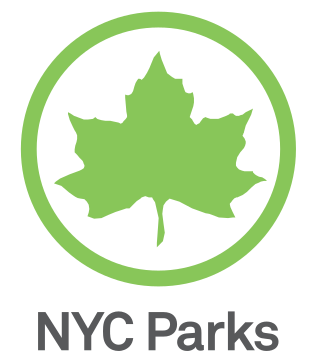Related Research Articles

The New York City Department of Parks and Recreation, also called the Parks Department or NYC Parks, is the department of the government of New York City responsible for maintaining the city's parks system, preserving and maintaining the ecological diversity of the city's natural areas, and furnishing recreational opportunities for city's residents and visitors.

The government of New York City, headquartered at New York City Hall in Lower Manhattan, is organized under the New York City Charter and provides for a mayor-council system. The mayor is elected to a four-year term and is responsible for the administration of city government. The New York City Council is a unicameral body consisting of 51 members, each elected from a geographic district, normally for four-year terms. All elected officials are subject to a two consecutive-term limit. The court system consists of two citywide courts and three statewide courts.

Sunset Park is a neighborhood in the southwestern part of the borough of Brooklyn in New York City, bounded by Park Slope and Green-Wood Cemetery to the north, Borough Park to the east, Bay Ridge to the south, and Upper New York Bay to the west. The neighborhood is named after a 24.5-acre (9.9 ha) public park of the same name, located between 41st and 44th Streets and Fifth and Seventh Avenues. The region north of 36th Street is also known as Greenwood Heights or South Slope.

Union Square is a historic intersection and surrounding neighborhood in Manhattan, New York City, United States, located where Broadway and the former Bowery Road – now Fourth Avenue – came together in the early 19th century. Its name denotes that "here was the union of the two principal thoroughfares of the island". The current Union Square Park is bounded by 14th Street on the south, 17th Street on the north, and Union Square West and Union Square East to the west and east respectively. 17th Street links together Broadway and Park Avenue South on the north end of the park, while Union Square East connects Park Avenue South to Fourth Avenue and the continuation of Broadway on the park's south side. The park is maintained by the New York City Department of Parks and Recreation.

The Joe DiMaggio Highway, commonly called the West Side Highway and formerly the Miller Highway, is a 5.42-mile-long (8.72 km) mostly surface section of New York State Route 9A (NY 9A), running from West 72nd Street along the Hudson River to the southern tip of Manhattan in New York City. It replaced the West Side Elevated Highway, built between 1929 and 1951, which was shut down in 1973 due to neglect and lack of maintenance, and was dismantled by 1989. North of 72nd Street the roadway continues north as the Henry Hudson Parkway.

Downtown Brooklyn is the third largest central business district in New York City, and is located in the northwestern section of the borough of Brooklyn. The neighborhood is known for its office and residential buildings, such as the Williamsburgh Savings Bank Tower and the MetroTech Center office complex.

The San Francisco Municipal Transportation Agency is an agency created by consolidation of the San Francisco Municipal Railway (Muni), the Department of Parking and Traffic (DPT), and the Taxicab Commission. The agency oversees public transport, taxis, bicycle infrastructure, pedestrian infrastructure, and paratransit for the City and County of San Francisco.

New York City Economic Development Corporation (NYCEDC) is a nonprofit corporation whose stated mission is to "strengthen confidence in NYC as a great place to do business; grow innovative sectors, with a focus on equity; build neighborhoods as places to live, learn, work, and play; and deliver sustainable infrastructure for communities and the city's future economy."

Community boards of Brooklyn are New York City community boards in the borough of Brooklyn, which are the appointed advisory groups of the community districts that advise on land use and zoning, participate in the city budget process, and address service delivery in their district.
The Optional Municipal Charter Law or Faulkner Act provides New Jersey municipalities with a variety of models of local government. This legislation is called the Faulkner Act in honor of the late Bayard H. Faulkner, former mayor of Montclair, New Jersey and chairman of the Commission on Municipal Government.
The borough president is an elected office in each of the five Boroughs of New York City. For most of the city's history, the office exercised significant executive powers within each borough, and the five borough presidents also sat on the New York City Board of Estimate. Since 1990, the borough presidents have been stripped of a majority of their powers in the government of New York City.

Travers Park is a 2-acre (8,100 m2) community park and playground in Jackson Heights, Queens, New York City. It is located between 77th and 78th Streets, on the north side of 34th Avenue. More than half of the park is occupied by an asphalt play area, with basketball and tennis courts. A children's playground with leaf-and-vine shaped spray shower occupies about one third of the park. There are also restroom facilities, handball courts, a dog run, picnic tables, a bicycle rack, benches, tables, and a lawn. In 2012, a segment of adjacent 78th Street was transformed into a permanent Street Plaza; the sports area of a nearby school was also bought by New York City and added to the park.

The New York City Department of Sanitation (DSNY) is the department of the government of New York City responsible for garbage collection, recycling collection, street cleaning, and snow removal. The DSNY is the primary operator of the New York City waste management system.

In New York City, there is an extensive water supply system that supports several programs and infrastructure pertaining to the city's food supply. City officials, agencies, and organizations cooperate with rural farmers to grow food more locally, as well as protect waterways in the New York metropolitan area. The New York City Department of Education operates a school-time and summertime breakfast/lunch program. The city is also deprived of supermarkets in several neighborhoods, and the city government has addressed the problem by allowing extra street vendors to operate. To encourage food safety, the government also operates a restaurant-grading system that it introduced in 2010. The various food programs have made the city a model for food systems internationally.

The community boards of the New York City government are the appointed advisory groups of the community districts of the five boroughs. There are currently 59 community districts: twelve in the Bronx, eighteen in Brooklyn, twelve in Manhattan, fourteen in Queens, and three in Staten Island.

The City of Muskogee is governed by a city manager, mayor and a city council under the council–manager form of local government. The governing document of Muskogee, Oklahoma is the City Charter of Muskogee.

There are over 50 farmer's markets in New York City in all boroughs, which operate under GrowNYC under the "Greenmarket" name. GrowNYC's food hub, "Greenmarket", includes Greenmarket Co., Youthmarket, Fresh Food Box, and the Wholesale Greenmarket under its programming. Greenmarket farmers market aims to encourage regional agriculture by allowing small family farms to sell their locally grown fruits, vegetables, flowers, dairy and other products, so that people in New York of all incomes and in all parts, have access to the fresh, nutritious, provincial, affordable and sustainable goods.

The Brooklyn–Queens Connector, abbreviated the BQX, is a proposed streetcar line in New York City. It is planned to operate on a north–south corridor along the East River between the boroughs of Queens and Brooklyn.

The Business Integrity Commission (BIC) is the agency of the New York City government responsible for regulating the private carting industry, public wholesale markets businesses, and the shipboard gambling industry. Its purpose is to combat corruption in these industries from organized crime, and was created from the 2001 Organized Crime Control Commission, itself created from the 1996 Trade Waste Commission, the Markets Division in the Small Business Services Department, and the Gambling Commission.

The government of Columbus, Ohio, headquartered at Columbus City Hall in Downtown Columbus, is organized into a mayor-council system. The mayor is responsible for the administration of city government. The Columbus City Council is a unicameral body consisting of seven members elected or appointed at-large. The city has numerous government agencies, responsible for public education, health, and safety; emergency services; recreational facilities; sanitation; water supply; and welfare services.
References
- ↑ New York City Charter § 191; "a. There shall be department of city planning, the head of which shall be the director of city planning. The director of city planning shall be the chair and a member of the city planning commission and shall serve at the pleasure of the mayor. [...]"
- ↑ About Us, New York City Department of City Planning . Accessed October 9, 2007.
- 1 2 City Planning Commission, New York City Department of City Planning. Accessed February 23, 2009.
- ↑ Dunlap, David W. "Some Land-Use History Highlights", The New York Times , April 12, 1992. Accessed February 23, 2009.
- ↑ Table of Commissioners - Terms of Office (1990 - Jan 2016), New York City Planning Commission
- ↑ Purdum, Todd S. "Charter Panel Agrees on Planning Commission Role", The New York Times , May 14, 1989. Accessed February 23, 2009.
- ↑ Benepe, Barry "Greenmarket, The Rebirth of Farmers Markets in New York City", "Council on the Environment of New York City", 1977. Accessed April 28, 2015.
